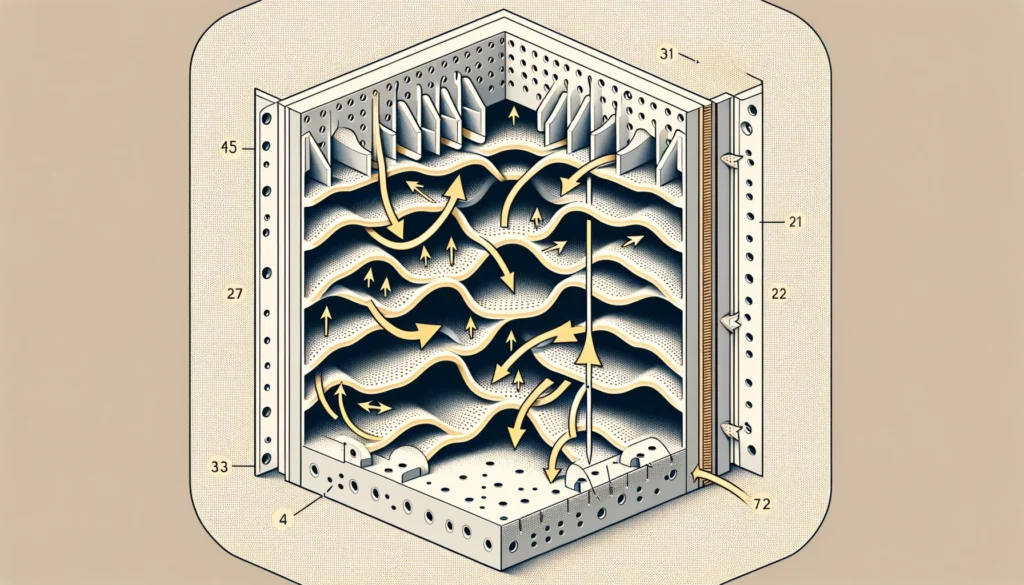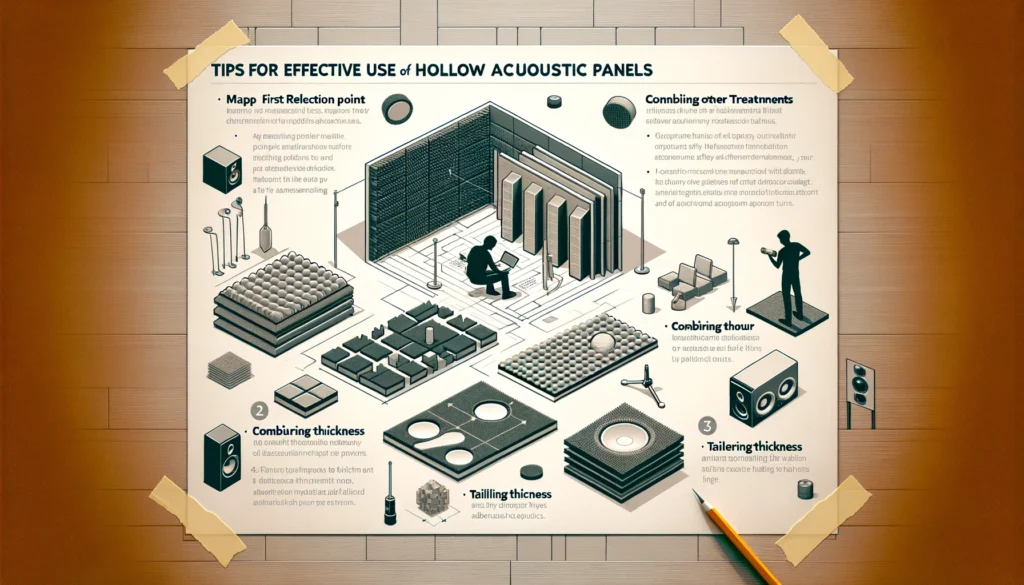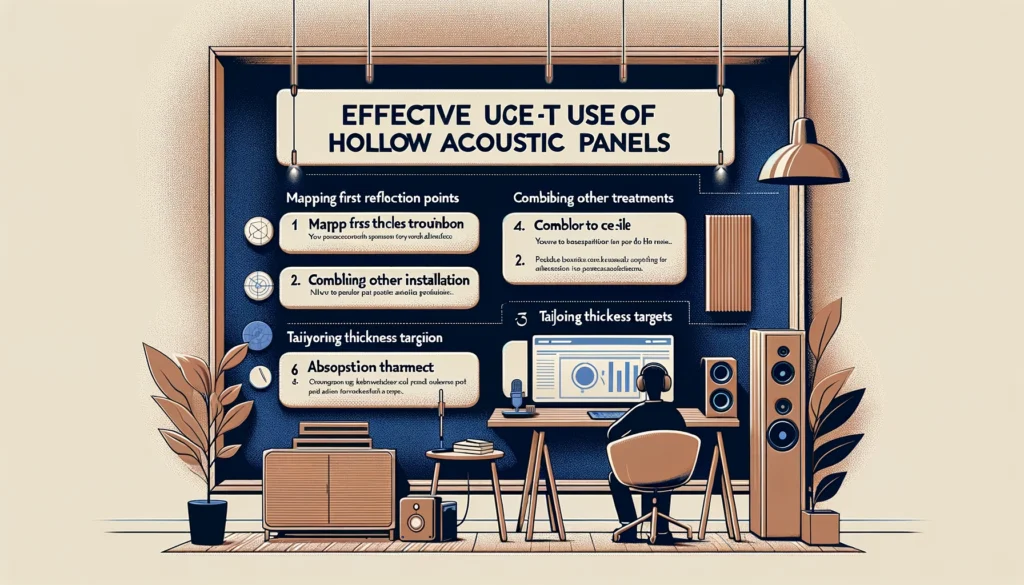Do your rooms suffer from bothersome echoes and reverberations that make media, music, and calls sound bright and hollow?
Hollow acoustic wall panels can provide an accessible acoustic treatment solution to tame mid and high pitch resonance issues without intensive construction.
Let’s explore what exactly these panels are, how they work on troublesome room acoustics, key benefits and limitations, and tips for effective use so you can determine if they might resolve your sound woes.
Are Hollow Acoustic Wall Panels an Effective Acoustic Treatment?

The quick answer is yes – when used properly, hollow acoustic wall panels can effectively absorb medium and high pitched resonance to reduce echo issues and bright, hollow sound in rooms.
However, they do have limitations at low frequencies and still require careful placement based on acoustic principles to truly maximize their benefit.
We will explore more on proper panel use below.
What Are Hollow Acoustic Wall Panels?

Hollow acoustic wall panels are thin panels made out of wood, metal, or plastic that have an air gap inside them to help absorb sound waves.
The panels often have perforations or slots that allow the sound waves to enter the interior cavity, where they then get trapped and absorbed rather than continuing to reverberate around the room.
The hollow acoustic panels come in a variety of shapes, sizes, and design styles.
Some common options include fabric wrapped squares or rectangles, wooden slats, interlocking geometric shapes, and abstract perforated metal panels.
This range allows the panels to not only treat the acoustics of a space but also contribute to the aesthetic style and interior design of the room.
How Do They Work?

When sound waves enter a room and hit a hard, flat surface, they are reflected back into the space which causes echo and reverberation.
The hollow acoustic panels help break up and absorb some of these sound waves rather than allowing them to continue reflecting around the room.
The slots, holes, and perforations on the surface of the hollow acoustic panel allow the sound waves to penetrate into the interior air cavity.
Once inside, the sound waves lose momentum as they bounce around and get dispersed in the cavity.
The soft fibers that make up panels constructed of material like wood also help contribute to absorption.
The result is less sound being reflected back into the room, reducing unwanted echo and reverberation.
Additionally, the panels help absorb medium and high frequency sounds, making the overall acoustics of a room less “live” sounding and more balanced.
They do not address low-frequency sounds as well, however, since longer bass waves require thicker panels to affect them.
But for troublesome mid to high pitched sounds, the hollow acoustic panels can help tame Issues like echo on calls, bright resonance, and more.
Benefits of Using Hollow Acoustic Panels

There are a few key benefits that hollow acoustic wall panels provide:
Improved Room Acoustics
The main benefit hollow acoustic panels offer is the ability to improve the overall acoustics of a room without requiring major construction or renovation.
Just strategically mounting the panels on key walls can tame echo and reverberation issues.
This allows better acoustics for music, media, and communication without a dramatic overhaul.
Absorption of Medium & High Frequencies
While acoustic panels do not address the full frequency spectrum, they are good at absorbing medium and high pitched sounds in the 250Hz to 4Khz range.
These frequencies contribute strongly to brightness and echo issues, so absorbing them with panels can make a notable difference in room resonance.
Design Flexibility
Unlike chunky acoustic foam squares, hollow panels come in a variety of materials from fabrics to wood to metal and can take on different shapes and designs.
This allows them to not only treat sound properly but also integrate into the aesthetic style of a room.
They can be made to match decor ranging from modern minimalist to industrial loft and more.
Cost Effective Solution
Compared to major insulation upgrades or conversion to dedicated acoustic spaces, hollow acoustic wall panels provide helpful acoustic treatment while remaining relatively affordable.
Just adding strategically placed panels offers big improvements without breaking budgets.
Limitations to Be Aware Of

While hollow acoustic wall panels provide meaningful acoustics benefits, there are some limitations to be aware of when planning treatment with these panels:
Low Frequency Sounds Untouched
The key drawback of hollow acoustic wall panels is that they do not help with low bass frequencies below 250Hz very well.
So issues like rumbling HVAC systems or media setups with powerful subwoofers would not get addressed.
Additional acoustic treatment focused on low frequencies would still be necessary.
Potential Durability Issues
Some hollow acoustic wall panel materials like fabric over wood frames may be prone to problems like sagging, cracking, or coming unglued over time.
Taking care to properly install hollow panels and choosing durable underlying materials can help maximize lifespan and performance.
Properly caring for panels helps maintain integrity.
Room Placement Strategy Required
To work effectively at reducing reverberation and bright, hollow acoustic wall panels need to be carefully placed based on room dimensions and trouble sound frequencies.
Mounting panels randomly on the wall will not deliver the full benefits.
Planning proper coverage for first reflections is key.
May Need Additional Treatments
While helpful at handling mid and high pitch echoes on their own, some rooms may have significant enough acoustic issues spanning from low to high frequencies that hollow panels alone will not suffice fully.
Combining additional bass traps and potentially broadband absorption may be required for full acoustic control.
Tips for Effective Use of Hollow Acoustic Wall Panels

Here are some top tips for making sure hollow acoustic wall panels are applied effectively:
Map First Reflection Points
Studying how sound moves and bounces in the room to identify the first reflection points that cause annoying echoes and targeting those areas specifically for hollow panel placement is hugely beneficial.
This ensures panels handle the most problematic sounds.
Combine Other Treatments
Do not rely just on the hollow acoustic panels alone.
Combine them strategically with thick absorption bass traps for low frequencies and potentially broadband absorbers and diffusers.
The combo ensures a balanced approach for handling the full spectrum properly.
Consider Floor to Ceiling Installation
If room aesthetics allow for it, running hollow acoustic panels from floor to ceiling rather than just mid-wall increases the surface area available for sound absorption and makes them more effective at reducing reverberation time and echo issues.
Tailor Thickness to Absorption Targets
The thicker the depth of the air cavity inside a hollow acoustic panel, the lower it can reach in absorbing low-end frequencies.
Choose panel depths strategically based on the nuisance frequencies experienced in the room when planning treatment.
Target absorption specs accordingly
The key with hollow acoustic wall panels is using them thoughtfully as part of a balanced acoustic treatment approach matched properly to the issues present in the room.
When installed strategically using acoustic principles, they can make notable improvements in taming troublesome echo and brightness problems.
However, they cannot treat issues like bass buildup alone which is where pairing them wisely with other specialized absorbers matters.
Applying fundamental acoustic treatment methodology allows hollow panels to contribute meaningfully to improving sound quality in rooms of all purposes.
Their ability to also integrate aesthetically with varied decor is an additional benefit driving effective options for reducing unwanted reverb and echo.
Conclusion
In conclusion, hollow acoustic wall panels can provide very meaningful acoustic improvements by absorbing mid and high frequency sounds if applied thoughtfully using acoustic treatment methodology.
However, their limitations with low bass frequencies means they cannot resolve all sound issues alone.
Pairing them strategically with additional specialized treatments allows hollow panels to contribute notably though to fixing bothersome brightness and echo problems.
